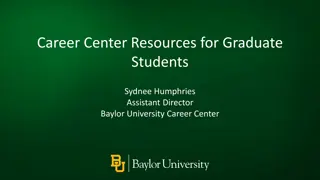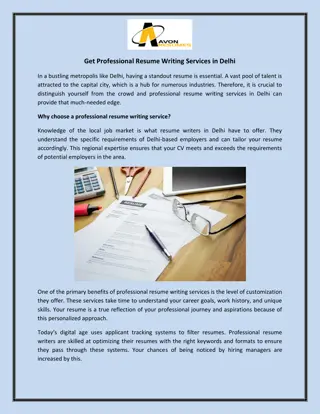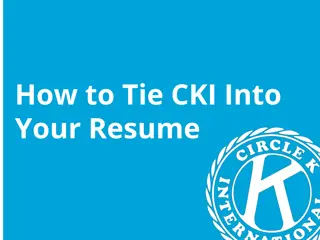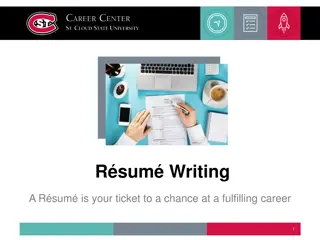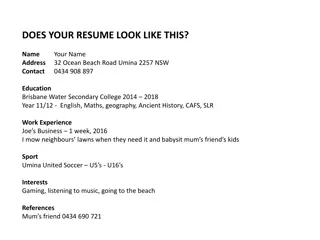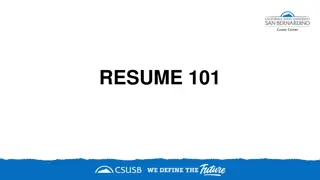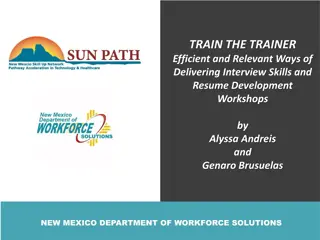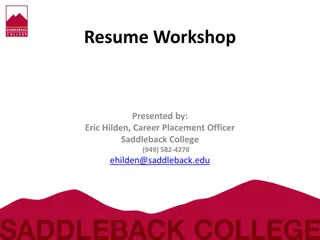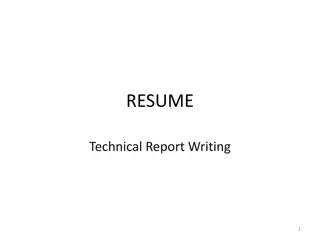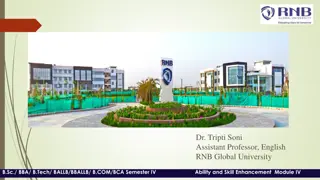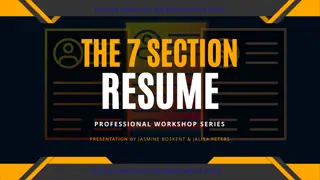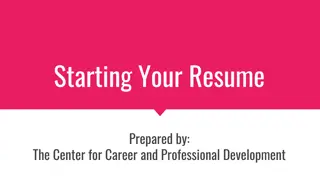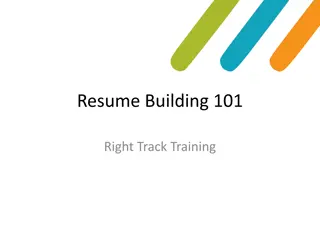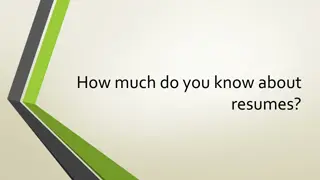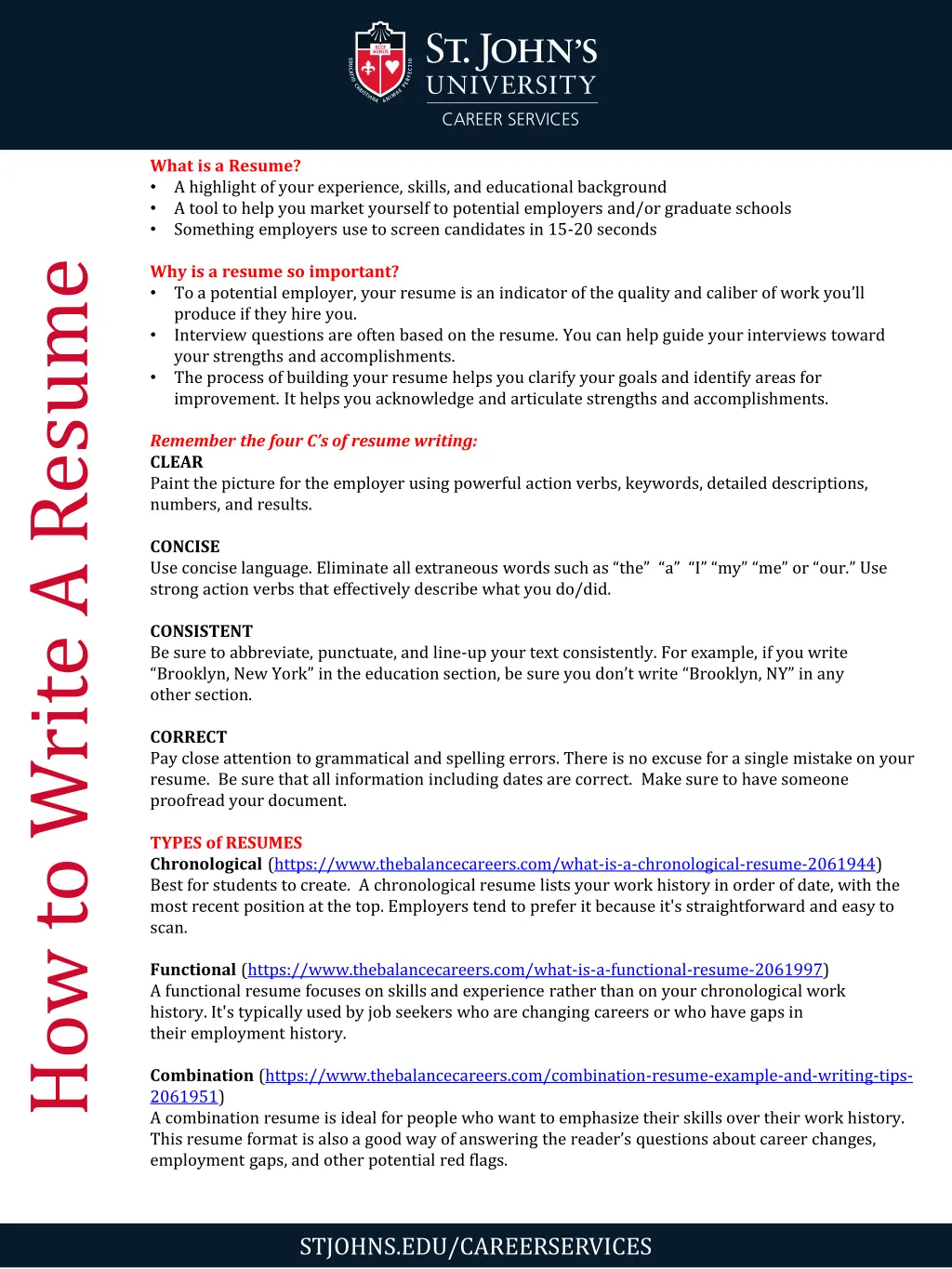
Tips for Crafting an Effective Resume
Learn the importance of resumes, essential writing tips, types of resumes, and how to set up your document effectively. Discover the significance of clear, concise, consistent, and correct content in your resume building process.
Download Presentation

Please find below an Image/Link to download the presentation.
The content on the website is provided AS IS for your information and personal use only. It may not be sold, licensed, or shared on other websites without obtaining consent from the author. If you encounter any issues during the download, it is possible that the publisher has removed the file from their server.
You are allowed to download the files provided on this website for personal or commercial use, subject to the condition that they are used lawfully. All files are the property of their respective owners.
The content on the website is provided AS IS for your information and personal use only. It may not be sold, licensed, or shared on other websites without obtaining consent from the author.
E N D
Presentation Transcript
What is a Resume? A highlight of your experience, skills, and educational background A tool to help you market yourself to potential employers and/or graduate schools Something employers use to screen candidates in 15-20 seconds How to Write A Resume Why is a resume so important? To a potential employer, your resume is an indicator of the quality and caliber of work you ll produce if they hire you. Interview questions are often based on the resume. You can help guide your interviews toward your strengths and accomplishments. The process of building your resume helps you clarify your goals and identify areas for improvement. It helps you acknowledge and articulate strengths and accomplishments. Remember the four C s of resume writing: CLEAR Paint the picture for the employer using powerful action verbs, keywords, detailed descriptions, numbers, and results. CONCISE Use concise language. Eliminate all extraneous words such as the a I my me or our. Use strong action verbs that effectively describe what you do/did. CONSISTENT Be sure to abbreviate, punctuate, and line-up your text consistently. For example, if you write Brooklyn, New York in the education section, be sure you don t write Brooklyn, NY in any other section. CORRECT Pay close attention to grammatical and spelling errors. There is no excuse for a single mistake on your resume. Be sure that all information including dates are correct. Make sure to have someone proofread your document. TYPES of RESUMES Chronological (https://www.thebalancecareers.com/what-is-a-chronological-resume-2061944) Best for students to create. A chronological resume lists your work history in order of date, with the most recent position at the top. Employers tend to prefer it because it's straightforward and easy to scan. Functional (https://www.thebalancecareers.com/what-is-a-functional-resume-2061997) A functional resume focuses on skills and experience rather than on your chronological work history. It's typically used by job seekers who are changing careers or who have gaps in their employment history. Combination (https://www.thebalancecareers.com/combination-resume-example-and-writing-tips- 2061951) A combination resume is ideal for people who want to emphasize their skills over their work history. This resume format is also a good way of answering the reader s questions about career changes, employment gaps, and other potential red flags. STJOHNS.EDU/CAREERSERVICES
Setting up the Document The format is very important as it will help you categorize your information into appropriate section headings. Open up a blank, new document and set even margins between .5 and 1inch with left aligned text Your overall font should be between 10 and 12pt. The lone exception is your name, which should be the biggest thing on the page (i.e. size 16 font). Use a conservative font (such as Arial, Calibri, Tahoma, Times New Roman) The Heading Your name and contact information is what serves as the header of the resume. Your name can be no larger than 16pt size font and the rest of the information between 10pt and 12pt. The rest of the text of your resume will also be within this smaller range. Example: WARREN GLICK Rego Park, NY 516-789-5678 Warren.Glick67@stjohns.edu The Section Headings Section headings are titles of categories of information. Every resume is different and depending on the experience you have and want to emphasize.Different section headings may be used and can also appear in different ways. Below are examples of section headings and what is typically housed in each: BRANDING STATEMENT (https://www.thebalancecareers.com/how-to-add-a-branding-statement-to-your-resume-2063330) A branding statement is a short, catchy statement that highlights your most relevant expertise in about 15 words or fewer. A strong branding statement conveys exceptional qualities, skills, experiences, or areas of knowledge that distinguish you from the average candidate. Your statement should express how you add value and produce results that impact the bottom line in your target sector. Example: Detail-oriented Development Assistant experienced in coordinating extensive fundraising efforts and drafting successful grant proposals. SUMMARY STATEMENT (https://www.thebalancecareers.com/how-to-write-a-resume-summary-statement-2061034) A resume summary statement is a brief list or a few sentences at the top of your resume that highlights your qualifications for a job. It showcases your most important credentials and is listed above your employment history. The person reviewing your resume will be able to view your most important attributes at a glance. **If you choose to use a summary statement, do not use a branding statement.** Example: Certified Workforce Development Professional / Career Specialist offering experience providing tailored career counseling, coaching, and job seeker services. Work well with clients from all walks of life to identify values, develop possible career paths, and design effective job search strategies. 90% successful employment placement rate. Proficient with database programs including Oracle and Microsoft SQL Server.
EDUCATION (https://www.thebalancecareers.com/college-student-resume-example-2063202) List degrees in reverse chronological order most recent first. If you are still pursuing your degree, you may list it in the same way as shown below, with your expected date of graduation stated. Other training you believe relevant to the position for which you are applying can also be shown here. For example: special seminars or relevant certifications, language, courses not available at your home institution, study abroad, or leadership training. Speak with your career & internship advisor about adding your GPA. Example: St. John's University Queens, NY Bachelor of Science in Biology Grad Date: Jan 2011 RELATED COURSEWORK / PROJECTS (https://www.thebalancecareers.com/student-resume-focusing-on-coursework-example-2063559) This section allows you to highlight the courses you took that are directly related to the position you are applying for. For example, if you're applying for work as a paralegal, list any classes you took related to law or politics. Always spell out the full name of the course: Example A: Introduction to Mass Communications, Fundamentals of Biology 1 If you have completed any research projects (individually or with classmates)related to your future career, list thesetoo: Example B: Introduction to Marketing: Worked with a team of classmates to create a marketing plan for the Girl Scouts of Nassau County to engage a wider audience to participate in program. HONORS/AWARDS This section houses scholarships, awards, honor society information, and other accomplishments to highlight. Example: Dean s List (fall 2013) | Order of Omega, St. John s University Merit Scholarship EXPERIENCE (https://www.thebalancecareers.com/what-to-include-in-a-resume-experience-section-2063320) Here you will list your past, current, and relevant work experience under headings such as: Professional Experience Internship Experience Relevant Work Experience Extra-Curricular Experience Industry Specific Experience (ex: Teaching Experience) This section will have entries that contain the following information: Name and location of organization (city and state only) Your title while employed there The dates of employment (months, seasons and/or years) Specific dates are not necessary to list A list of duties and accomplishments in bulleted or in narrative form using strong action verbs which correlate with specific words used in the job posting Example: Intern Jan. 2012 to Present Create widgets by hand utilizing special tools of the trade Organize widgets by size and shape according to company-made diagram Motivated co-workers to increase production by 25 percent in 2006 ABC Widget Factory, Ltd. Smalltown, NY When writing your bullet points or paragraph form descriptions of your duties and responsibilities, always start with an action verb. Refer to the following list of action verbs to be sure you don t overuse the same word.
Action Verbs When describing your experience use the formula: Action Verb + Who/What does that action pertain to + How/Why did you perform the action? Utilize a variety of verbs to keep the reader interested | Describe accomplishments, not just job duties | Remember to use the appropriate tense for past and present experiences. Communication/People Skills Management/Leadership Skills Analytical/Organizational Skills Analyzed Approved Arranged Catalogued Categorized Charted Clarified Classified Coded Collected Compared Compiled Conducted Corrected Corresponded Critiqued Detected Determined Diagnosed Distributed Evaluated Examined Executed Experimented Explored Extracted Filed Formulated Gathered Generated Identified Implemented Incorporated Inspected Interviewed Invented Investigated Located Logged Accounted Addressed Advertised Advised Arbitrated Arranged Articulated Assisted Authored Clarified Coached Collaborated Communicated Composed Condensed Conferred Consulted Contacted Conveyed Convinced Coordinated Corresponded Counseled Debated Defined Demonstrated Described Developed Directed Disciplined Discussed Drafted Edited Elicited Enlisted Entertained Explained Expressed Formulated Furnished Guided Hired Incorporated Influenced Interacted Interpreted Interviewed Invented Involved Joined Judged Lectured Listened Marketed Mediated Moderated Negotiated Observed Outlined Participated Persuaded Presented Promoted Proposed Publicized Reconciled Recruited Referred Reinforced Reported Resolved Responded Solicited Specified Spoke Suggested Surveyed Summarized Synthesized Translated Transported Tutored Wrote Administered Analyzed Appointed Approved Assigned Attained Authorized Chaired Combined Condensed Considered Consolidated Contracted Controlled Converted Coordinated Created Customized Decided Delegated Designed Developed Directed Displayed Eliminated Emphasized Enforced Enhanced Established Executed Formulated Founded Generated Handled Headed Hired Hosted Improved Initiated Incorporated Increased Initiated Inspected Instituted Integrated Introduced Led Managed Merged Modeled Modified Motivated Navigated Organized Originated Overhauled Oversaw Performed Planned Presided Prioritized Produced Recommended Reorganized Replaced Restored Reviewed Revised Revitalized Scheduled Secured Selected Shaped Solved Streamlined Strengthened Supervised Terminated Maintained Measured Monitored Obtained Operated Ordered Organized Prepared Processed Provided Purchased Recorded Registered Researched Reserved Responded Reviewed Routed Searched Scheduled Screened Set up Solved Submitted Summarized Supplied Surveyed Standardized Systematized Tested Updated Validated Verified TIPS ON USING ACTION VERBS ON A RESUME https://www.thebalancecareers.com/list-of-resume-and-cover-letter-keywords-2060287)
SKILLS (https://www.thebalancecareers.com/what-to-include-in-a-resume-skills-section-2063321) Emphasizing additional skill sets is just as important as listing your past work experiences.The skills section of your resume includes your abilities that are related to the jobs you are applying for. You should list skills that are relevant to the position or career field that you are interested in. Computer Skills: Microsoft Office: Word, Power Point | Adobe Photoshop | Instagram | Twitter Language Skills: (Fluent) French | (Conversational) Italian REFERENCES (https://www.thebalancecareers.com/should-you-include-references-on-your-resume-2062976) A list of strong references can be a great way to demonstrate your qualifications for a position. It's important to havepeople who can vouch for your abilities and skills when applying for jobs but offering a list of references right out of the gate is not always the best policy. However, providing a portfolio offers another chance for you to give more information. For example, if you have writing sampleson a website or artwork, you can put the URL on the bottom of your resume. You can also house your LinkedIn profile here as well. Example: www.katiemauro.com www.linkedin.com/pub/Katie-Mauro THINGS TO REMEMBER Make it Unique Tailor your resume for each position. Look at the job/internship posting, see what qualities and experience the company is looking for, and adapt your resume to highlight your skills and experience that best match the position. Avoid The Resume Wizard Resume templates found on most computer software do not offer the opportunity to truly manipulate your document and are also easily recognizable by employers. Additionally, if you are indicating that you are proficient in programs such as Microsoft Word, you should be able to create an aesthetically pleasing document manually. Focus on Aesthetics Utilize CAPITALIZING, italicizing, bolding, underline, and spacing to guide the reader and emphasizeaccomplishments. Choose one or two, not all. Do not over format any one piece of information You can line up your text properly by using the TAB key instead of the SPACE bar. You can determine if your text is lined up by the points on the ruler at the top and side of your document. (Try to) Keep it to One Page Your resume should be 1 full page with little to no white space. This will challenge you to be sure to include on the most relevant and important information. Save It and Send It Most resumes are sent via email as an attachment. Best practice is to Save As in Microsoft Word - PDF is a great choice for MAC users and if one does not have MS Word. Applicant Tracking Systems (https://www.thebalancecareers.com/how-to-get-your-resume-past-the-applicant-tracking-system- 2063135) typically read Word easier. Make sure to upload your resume into Handshake as well. Continuously Update The resume is a working document and should be updated even after you secured an internship or job. TIPS FOR WRITING YOUR FIRST RESUME (https://www.thebalancecareers.com/tips-for-writing-your-first-resume-2058744)

